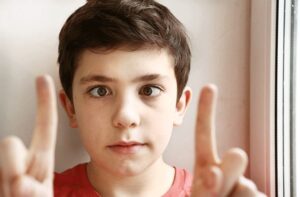Guest Blog: Amblyopia Or Lazy Eye–A Silent Menace In Small Children


Perhaps you may have heard of a child having Lazy Eye, also known as Amblyopia. What exactly is this rather mysterious-sounding eye abnormality? Simply put, an eye is termed “lazy” when a child does not see with it despite wearing glasses. Now, you may instantly jump to the conclusion that it might be because the glasses do not have the correct “power”. However, in the case of Lazy Eye, even when the “power” of the eye has been calculated correctly, the eye may not see at all. Such an abnormality of the eye is caused by nerve pathways between the brain and the eye being improper, thereby leading the brain to “favor” one eye and dismiss the other as “lazy”.
Let us consider an analogy. The eye functions like a mobile phone camera. Both are capable of taking pictures continuously. The phone camera can take clear selfies when it focuses well. Else the pictures turn out blurred when it cannot focus properly. The pictures are then automatically processed by the camera and the best selfie is selected. Similarly, the brain processes only those pictures which are clear. When a child does not wear the correct glasses, the eye fails to focus clearly. It repeatedly “clicks” blurred pictures and sends them to the brain. The brain, in turn, rejects these images from the “faulty” eye while forwarding the images “clicked” by the better eye. Thus the “faulty” eye despite its ability to “see” cannot see! This is when the eye becomes “lazy”. So Lazy Eye is, in fact, a problem of visual processing rather than a problem of the eyeball itself.
If detected early in childhood, Lazy Eye can be corrected completely. A lazy eye simply needs to do more work! But how can this be achieved? For this, the “power” of the lazy eye is accurately corrected so that when proper glasses are worn, the eye can focus and send clear pictures to the brain. However, in this case, the brain is already tuned to ignoring the images from the lazy eye and processes only the images from the “better eye”. So, what does the eye doctor do to redeem the situation and force the brain to see images from the “lazy eye” as well? The doctor simply covers the better eye, and this literally forces the brain to recognize images from the lazy eye.
So don’t panic if a child in your household has been detected with Lazy Eye (Amblyopia). Simple treatment and lots of encouragement are all that are needed to treat a lazy eye.
But haven’t we heard that “prevention is better than cure”? Lazy eyes can be prevented. This can be done by encouraging children to have a mandatory eye check-up before they start junior school (Class 1 or 5 years of age) and in case of requirement, give them correct powered glasses. This is the first step in preventing the development of a Lazy Eye.
About the author- Dr.Ipsita Basu MBBS, DO, DNB, DipNB, Consultant – Paediatric Ophthalmology, Disha Eye Hospitals
